
Operation Torch was an Allied invasion of French North Africa during the Second World War. Torch was a compromise operation that met the British objective of securing victory in North Africa while allowing American armed forces the opportunity to engage in the fight against Nazi Germany on a limited scale. It was the first mass involvement of US troops in the European–North African Theatre, and saw the first major airborne assault carried out by the United States.
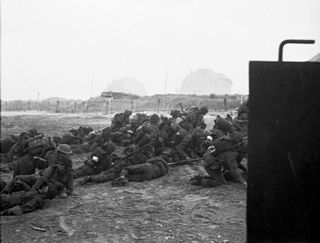
Sword, commonly known as Sword Beach, was the code name given to one of the five main landing areas along the Normandy coast during the initial assault phase, Operation Neptune, of Operation Overlord, the Allied invasion of German-occupied France that commenced on 6 June 1944. Stretching 8 kilometres (5.0 mi) from Ouistreham to Saint-Aubin-sur-Mer, the beach proved to be the easternmost landing site of the invasion after the abortion of an attack on a sixth beach, code-named Band. Taking Sword was to be the responsibility of the British Army with sea transport, mine sweeping, and a naval bombardment force provided by the British Royal Navy as well as elements from the Polish, Norwegian and other Allied navies.

The 3rd Infantry Division is a combined arms division of the United States Army based at Fort Stewart, Georgia. It is a direct subordinate unit of the XVIII Airborne Corps and U.S. Army Forces Command. Its current organization includes a division headquarters and headquarters battalion, two armored brigade combat teams, one National Guard infantry brigade combat team, one task force battalion, one aviation brigade, a division artillery, a sustainment brigade and a combat sustainment support battalion along with a maneuver enhancement brigade. The division has a distinguished history, having seen active service in World War I, World War II, the Korean War, Vietnam War, and the Global War on Terror. The Medal of Honor has been awarded to 61 members of the 3rd Infantry Division, making the division the most honored in the Army.

The 36th Infantry Division ("Arrowhead"), also known as the "Panther Division", "Lone Star Division", "The Texas Army", or the "T-patchers", is an infantry division of the United States Army and part of the Texas Army National Guard. It was organized during World War I from units of the Texas and Oklahoma National Guard. As an all-Texas unit, it was called for service for World War II 25 November 1940, was sent to the European Theater of Operations in April 1943, and returned to the Texas Army National Guard in December 1945.

Operation Ladbroke was a glider landing by British airborne troops during the Second World War near Syracuse, Sicily, that began on 9 July 1943 as part of Operation Husky, the Allied invasion of Sicily. The first Allied mission using large numbers of the aircraft, the operation was carried out from Tunisia by glider infantry of the British 1st Airlanding Brigade, commanded by Brigadier Philip Hicks, with a force of 136 Waco Hadrians and eight Airspeed Horsas. The objective was to establish a large invasion force on the ground near the town of Syracuse, secure the Ponte Grande Bridge and ultimately take control of the city itself with its strategically vital docks, as a prelude to the full-scale invasion of Sicily.

Operation Fustian was an airborne forces operation undertaken during the Allied invasion of Sicily in July 1943 in the Second World War. The operation was carried out by Brigadier Gerald Lathbury's 1st Parachute Brigade, part of the British 1st Airborne Division. Their objective was the Primosole Bridge across the Simeto River. The intention was for the brigade, with glider-borne forces in support, to land on both sides of the river. They would then capture the bridge and secure the surrounding area until relieved by the advance of British XIII Corps, which had landed on the south eastern coast three days previously. Because the bridge was the only crossing on the river and would give the British Eighth Army access to the Catania plain, its capture was expected to speed the advance and lead to the defeat of the Axis forces in Sicily.

The 1st Infantry Division is a combined arms division of the United States Army, and is the oldest continuously serving division in the Regular Army. It has seen continuous service since its organization in 1917 during World War I. It was officially nicknamed "The Big Red One" after its shoulder patch and is also nicknamed "The Fighting First." The division has also received troop monikers of "The Big Dead One" and "The Bloody First" as puns on the respective officially sanctioned nicknames. It is currently based at Fort Riley, Kansas.

The 4th Infantry Division is a division of the United States Army based at Fort Carson, Colorado. It is composed of a division headquarters battalion, three brigade combat teams, a combat aviation brigade, a division sustainment brigade, and a division artillery.

Gold, commonly known as Gold Beach, was the code name for one of the five areas of the Allied invasion of German-occupied France in the Normandy landings on 6 June 1944, during the Second World War. Gold, the central of the five areas, was located between Port-en-Bessin on the west and La Rivière on the east. High cliffs at the western end of the zone meant that the landings took place on the flat section between Le Hamel and La Rivière, in the sectors code-named Jig and King. Taking Gold was to be the responsibility of the British Army, with sea transport, mine sweeping, and a naval bombardment force provided by the Royal Navy as well as elements from the Dutch, Polish and other Allied navies.

The 9th Infantry Division is an inactive infantry division of the United States Army. It was created as the 9th Division during World War I, but never deployed overseas. In later years, it would become an important unit of the U.S. Army during World War II and the Vietnam War. It was also activated as a peacetime readiness unit from 1947 to 1962 at Fort Dix, New Jersey, and Fort Carson, Colorado, and from 1972 to 1991 as an active-duty infantry division at Fort Lewis, Washington. Nicknamed the "Old Reliables", the division was eventually deactivated in December 1991.
Operation Husky order of battle is a listing of the significant military and air force units that were involved in the campaign for Sicily, July 10 – August 17, 1943.
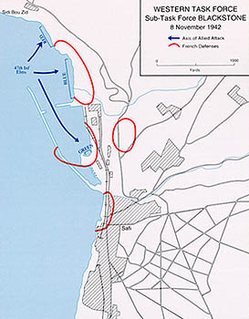
Operation Blackstone was a part of Operation Torch, the Allied landings in North Africa during World War II. The operation called for American amphibious troops to land at and capture the French-held port of Safi in French Morocco. The landings were carried out by the 47th Infantry Regiment of the U.S. Army and took place on the morning of 8 November 1942 as part of a larger operation to capture Casablanca.

The U.S. 60th Infantry Regiment is a regimental unit in the United States Army. Its 2nd and 3rd Battalion conduct Basic Combat Training.

Mission Albany was a parachute combat assault at night by the U.S. 101st Airborne Division on June 6, 1944, part of the American airborne landings in Normandy during World War II. It was the opening step of Operation Neptune, the assault portion of the Allied invasion of Normandy, Operation Overlord. 6,928 paratroopers made their jumps from 443 C-47 Skytrain troop carrier planes into an intended objective area of roughly 15 square miles (39 km2) located in the southeast corner of the Cotentin Peninsula of France five hours ahead of the D-Day landings. The landings were badly scattered by bad weather and German ground fire over an area twice as large, with four sticks dropped as far as 20 miles (32 km) away.
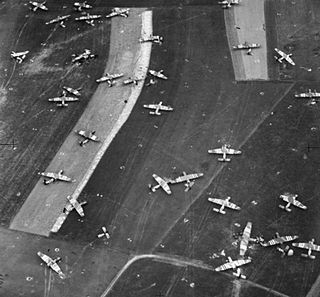
Operation Mallard was the codename for an airborne forces operation, which was conducted by the British Army on 6 June 1944, as part of the Normandy landings during the Second World War.

The 64th Infantry Division "Catanzaro" was an infantry division of the Royal Italian Army during World War II. The division was activated on 3 June 1940 and named for the Southern Italian city of Catanzaro. The division's regimental depots were in mainland Italy in Calabria and shared with other divisions recruiting in the region. The division was classified as an auto-transportable division, meaning staff and equipment could be transported on cars and trucks, although not simultaneously. The division took part in the Italian invasion of Egypt and was destroyed on 5 January 1941 during the Battle of Bardia.

The 78th Field Artillery Regiment is a field artillery regiment of the United States Army. Initially activated on 1 July 1916, the 78th Field Artillery Battalion did not see action in World War I, but would later be reactivated at the start of World War II and participate in the campaigns for Algeria-French Morocco, Sicily, Normandy, Northern France, Ardennes-Alsace, Central Europe, and the Rhineland with the 2d Armored Division. The 78th Artillery Battalion's six batteries were reorganized into separate battalions in 1957, with the 1st Battalion, 78th Field Artillery being the only remaining active unit of the 78th Field Artillery. The 1st Battalion, 78th Field Artillery is assigned to the 428th Field Artillery Brigade, supporting the Fires Center of Excellence mission through the conduct of Initial Entry Training in order to provide the Army with combat ready Field Artillery Soldiers. The 1st Battalion, 78th Field Artillery conducts Advanced Individual Training for the 13-series Military Occupational Specialties (MOS) of 13B, 13F, 13J, 13M, and 13R.
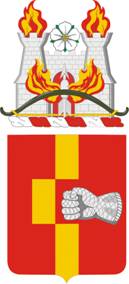
The 92nd Field Artillery Regiment is an inactive parent regiment of the Field Artillery Branch of the United States Army. It was constituted in 1933, with its last active battalions, the 1st and 3rd Battalions, inactivated in 1996.
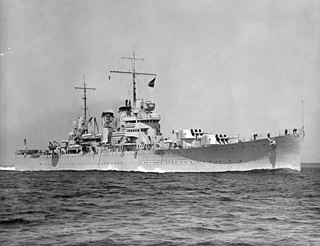
The amphibious Battle of Gela was the opening engagement of the American portion of the Allied Invasion of Sicily during World War II. United States Navy ships landed United States Army troops along the eastern end of the south coast of Sicily; and withstood attacks by Luftwaffe and Regia Aeronautica aircraft while defending the beachhead against German tanks and Italian tanks of the Livorno Division until the Army captured the Ponte Olivo Airfield for use by United States Army Air Forces planes. The battle convinced United States Army officers of the value of naval artillery support, and revealed problems coordinating air support from autonomous air forces during amphibious operations.

The Japanese invasion of Lingayen Gulf was the key point in the Japanese plan for the conquest of the Philippines. Preparations had already been made by the Attack on Clark Field and the landings of Japanese forces at five points in northern and southern Luzon and Mindanao in early/mid December 1941, with the IJAAF seizing air fields and basing aircraft for ground support, and the Imperial Japanese Navy establishing seaplane bases at the Camiguin Island, Legaspi, and Davao. The main landing of Japanese forces targeted Lingayen Gulf, with its proximity to the Philippine capital of Manila, and Lamon Bay on the opposite coast to the south.



















